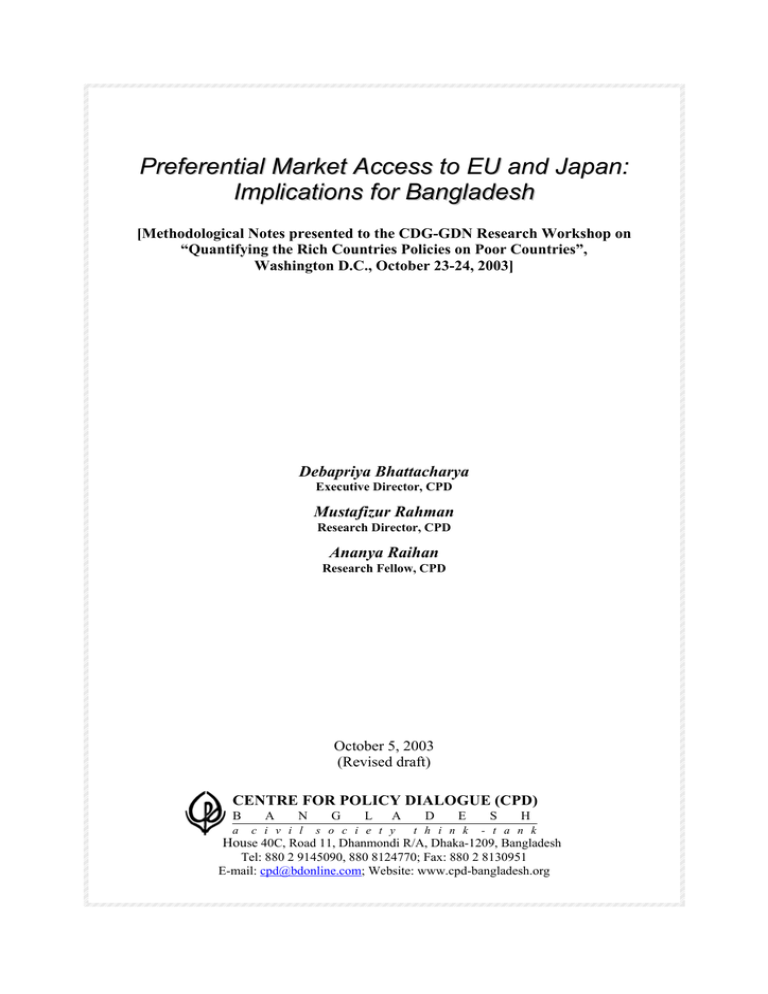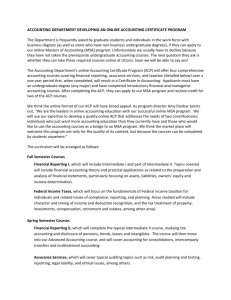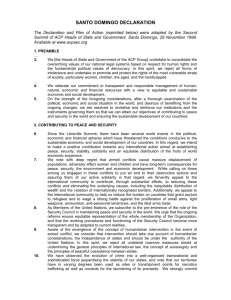P r e f
advertisement

Preferential Market Access to EU and Japan: Implications for Bangladesh [Methodological Notes presented to the CDG-GDN Research Workshop on “Quantifying the Rich Countries Policies on Poor Countries”, Washington D.C., October 23-24, 2003] Debapriya Bhattacharya Executive Director, CPD Mustafizur Rahman Research Director, CPD Ananya Raihan Research Fellow, CPD October 5, 2003 (Revised draft) CENTRE FOR POLICY DIALOGUE (CPD) B a A N c i v i l G L A s o c i e t y D E t h i n k S H - t a n k House 40C, Road 11, Dhanmondi R/A, Dhaka-1209, Bangladesh Tel: 880 2 9145090, 880 8124770; Fax: 880 2 8130951 E-mail: cpd@bdonline.com; Website: www.cpd-bangladesh.org CPD Study on Preferential Market Access to EU and Japan: Implications for Bangladesh Estimating Impact of Preferential Market Access Offered by EU and Japan to Bangladesh – A Methodological Note 1. Objectives i. Assessment of impact of enhanced preferential treatment by EU under EBA and by Japan ii. Identification of products which have potential in EU and Japan due to the new facilities iii. Policy implications arising out of the EU-EBA and Japan’s offer 2. Source of Information i. ii. GTAP Database: First introduced in 1994, Bangladesh was included in GTAP 5.0 in 2000, the base period of the GTAP 5.0 was 1997. Trade Map Database, ITC-UNCTAD-WTO (World price, import price, export volume from beneficiary countries, import volume form the world etc.) 3. Assumptions i. ii. iii. iv. v. vi. vii. viii. ix. Non-convexities in preferences and technologies are kept out of the framework The model is based on assumption of perfect competition, absence of market failures and non-convexities in production Factors are immobile across the national boundaries No dynamic considerations related to capital accumulation and technical change over time Ex-ante analysis The elasticity of substitution between any pair of domestic and imported goods is constant within each sector and the elasticity of substitution between each pair of imported goods originating from different countries is twice higher than that between domestic and foreign goods [Armington Differentiation]. The production side of the model assumes fixed production coefficients between primary and intermediate inputs [Leontief Aggregation] Production factors are fully employed Primary production factors [agricultural land, skilled and unskilled labour and capital] are mobile across the sector, captured by constant elasticity of transformation (CET). 4. Variables i. Endogenous: trade flows ( export and import), consumption through expenditure (household expenditure, public expenditure, private expenditure, investment), production ( sectoral) ii. Exogenous: policy variables like tariff, tariff equivalent of quota, tariff equivalent of Rules of Origin restriction. 5. Advantages of General Equilibrium Framework (GEF) and CGE Modelling i. A general equilibrium setting is preferable when the policy experiment to be modelled affects simultaneously many countries and many sectors. CPD: EU & Japan Market Access from Bangladesh 1 ii. iii. iv. The GEF allows considering consumption of all goods by the rest of the world thus allows to estimate income effect of non-reciprocal preferential treatment, which is not possible by partial equilibrium analysis. General equilibrium model can capture inter-sectoral linkage effects. Partial equilibrium models neglect offsetting effects following liberalisation and working through inter-sectoral shifts, factor price adjustment and exchange rate changes. The GEF addresses these issues reasonably. 6. Disadvantages i. ii. iii. iv. v. Results are sensitive to elasticities used, which are fixed for a particular situation [Constant elasticity of substitution among exports of different origin], which have strong implication for the estimate of trade creation or trade diversion. The Armington assumption states that commodities imported and exported are imperfect substitutes of domestically produced and used commodities. This assumption is necessary to take into account two-way trade, while an unrealistically high degree of specialisation is avoided. The imported (exported) and domestically produced (demanded) commodity are aggregated into a new composite commodity using constant returns to scale CES (Constant Elasticity of Transformation; CET) functions. This may lead to over-estimation of terms of trade effects. The model is based on assumption of perfect competition, absence of market failures and non-convexities in production. However, the perfect competition is not characteristic for majority of products traded in the world market. It is to be mentioned that this drawback is representative of all methodologies. It is assumed that factors are immobile across the national boundaries. However, the mobility of capital is one of the fundamental factors accelerating globalisation. Thus, ignoring the movement of capital across the border (particularly when it happens in response to incremental market opportunities) is a major weakness of the method. The constant elasticity of substitution undermines efficiency gain and productivity factor in international competition. 7. Model Structure i. ii. iii. The world has been divided into 10 regions a. Preference Donor Countries (4): EU, US, Japan, QUAD b. Beneficiary Countries (3): Bangladesh, ACP-LDC region, other ACP region c. Third Countries (4): India, Mexico, China, Rest of the World The productive sectors have been aggregated in to 10 sectors: Apparel, Textiles, Leather, Fish, Vegetables, Sugar, Other Food, Other Primary, Other Manufacturing Equation Blocks a. Price Equations b. Supply Equations c. Factor Demand and Export Supply Equations d. Trade and Final Demand Equations e. Income and Savings Equations f. General Equilibrium Conditions g. Welfare Measure: Hicksian equivalent variation (EV), with changes in government consumption and investment spending valued according to private household's preference CPD: EU & Japan Market Access from Bangladesh 2 iv. Parameters a. Share parameters estimated from SAM of each countries b. Elasticity parameters describing curvature of various structural functions c. Institutional parameters (e.g. quotas) 8. Key mechanics 1. Substitute relationships in consumption and production between close substitute of goods 2. Parameters like supply elasticities and own cross-price elasticities of demand are in use 9. Results The results of the exercise are presented in the Annex. 10. Future Use of Method Given the Trade Map data are accessible for all products, countries and with a time series, analysis for identification of products, which have potential in the preference donor countries will be possible to perform at more disaggregate layer, which are more useful at the entrepreneur level. Despite the legitimate criticism of the CGE modelling, it will continue to be used by the policy researchers across the world, as there is no credible alternative to it. Furthermore, the methodology for dynamic CGE modelling is being improved continuously. The problem is availability of reliable detailed social accounting matrix and time series data for all countries. Incorporation of Migration in the Trade Model: In the current GTAP structure, the incorporation of migration into the trade model directly is not possible, as the international factor mobility is not allowed. However, a proxy may be worked out through the remittance earning, which is a part of balance of payments component of the model. As we know, the proportion of remittance is different for various skill groups - less the skill, the higher is the proportion of income remitted to the country of worker’s origin. Thus far, in developing the proxy variable the differential of remittance by skilled category may be incorporated. 11. Further Areas of Research General Extrapolation of results of CGE Modelling for estimating current benefit or loss from preferential treatment Methodological aspects for CGE Modelling of service sector liberalisation For Bangladesh Ex-post analysis of impact of preferential treatment (dataset) Analysis of impact of AGOA on Bangladesh CGE Modelling of SAPTA and analysis of benefit and losses of Regional Agreement to Member Countries CPD: EU & Japan Market Access from Bangladesh 3 Annex I. MATRIX ON METHODOLOGY: EU-EBA Simulation I. Elimination of all tariff and non-tariff barriers (except sugar and service sectors) against LDCs in the EU II. Elimination of all tariff and nontariff (quota) barriers (except service sector) in EU elimination of all tariff and nontariff barriers against ACP countries III. Elimination of all tariff and non-tariff (quota) barriers (except sugar and service sectors) for Bangladesh and ACP countries in EU, countries under USTDA in US and Mexico in US and Canada Variables under control Rationale of such control Expected Outcome of Simulation Rules of Origin Restrictions for Bangladesh in the apparel and textile sector Isolating all other dynamics Isolating all other dynamics To measure only the impact of EU-EBA initiative Little benefit for Bangladesh due to RoO restrictions As EU also offers duty free quota free access to ACP countries, The simulation will allow to understand combined effect Due to the production structure of ACP countries benefit for the ACP countries from the ACP initiative is much higher than the benefit from EU-EBA for Bangladesh Rules of Origin Restrictions against Bangladesh and ACP in EU in the apparel and textile sector Rules of Origin Restrictions against countries under USTDA Act 2000 in US and Mexico in the US and Canada Isolating all other dynamics The said preferential treatments are of simultaneous concurrence, a combined impact is essential is to identify the true incremental benefit of these initiatives Bangladesh has little to gain from this initiative as the Room restriction is there CPD: EU & Japan Market Access from Bangladesh Result of Simulation Change (%) in Aggregate Export, [Mln US$] BD: 0.97%, [52.6 mln US$] ACP-LDC: 0.4% [213.22 mln US$] Other ACP: 0.01% [11.81 mln US$] Change (%) in Terms of Trade BD: 1.66% ACP-LDC: 1.27% Other ACP 0.02% BD: 0.097% ACP-LDC: 0.085% Other ACP 0.002% Change (%) in Regional HH Income BD: 2.31% ACP-LDC: 1.69% Other ACP 0.03% BD: 1.89%, [102.29 mln US$] ACP-LDC: 0.59% [312.05 mln US$] Other ACP: 0.54% [457.68 mln US$] BD: 2.81% ACP-LDC: 1.73% Other ACP 1.26% BD: 0.18% ACP-LDC: 0.12% Other ACP 0.14% BD: 3.93% ACP-LDC: 2.32% Other ACP 1.95% BD: 0.96%, [52.2 mln US$] ACP-LDC: 0.41% [217.3 mln US$] Other ACP: 0.91% [772.01 mln US$] BD: 1.63% ACP-LDC: 1.27% Other ACP 1.8% BD: 0.09% ACP-LDC: 0.08% Other ACP 0.21 BD: 2.27% ACP-LDC: 1.74% Other ACP 2.83% Change (%) in GDP 4 Simulation IV. Elimination of all tariff and non-tariff (quota) Variables under control Rationale of such control Expected Outcome of Simulation Isolating all other dynamics To understand the extent of impact of Japan’s initiative Due to low base level trade the impact will be insignificant, however, it does not provide for conclusion on the lack of impact Result of Simulation Change (%) in Aggregate Export, [Mln US$] BD: 0.18%, [9.95 mln US$] ACP-LDC: 0.09% [49.64 mln US$] Other ACP: 0.004% [3.66 mln US$] Rules of Origin Restrictions against Bangladesh and ACP in EU in the apparel and textile sector Rules of Origin Restrictions against countries under USTDA Act 2000 in US and Mexico in the US and Canada Room against LDC in Japan Isolating all other dynamics This simulation is an improved version of simulation III inclusive of Japan’s initiative. The benefit for Bangladesh will be more than only EU scenario. However, the extent is not high due to the RoO restriction BD: 1.14%, [61.83 mln US$] ACP-LDC: 0.41% [217.37 mln US$] Other ACP: 0.91% [772.14 mln US$] barriers (except sugar and service sectors) against Change (%) in Terms of Trade BD: 0.36% ACP-LDC: 0.32% Other ACP 0.01% BD: 0.02% ACP-LDC: 0.021% Other ACP 0.0008% Change (%) in Regional HH Income BD: 0.51% ACP-LDC: 0.43% Other ACP 0.01% BD: 1.99% ACP-LDC: 1.27% Other ACP 1.80% BD: 0.114% ACP-LDC: 0.084% Other ACP 0.213% BD: 2.78% ACP-LDC: 1.74% Other ACP 2.83% Change (%) in GDP LDC in Japan V. Elimination of all tariff and non-tariff (quota) barriers (except sugar and service sectors) for Bangladesh and ACP countries in the EU, against LDC countries in Japan, against countries under USTDA 2000 Act in the US and against Mexico in the US and Canada. CPD: EU & Japan Market Access from Bangladesh 5




